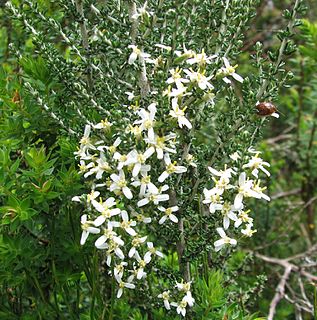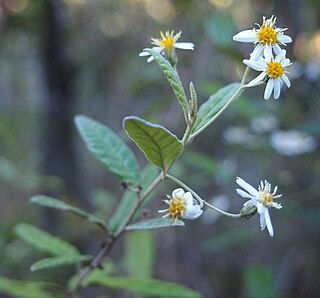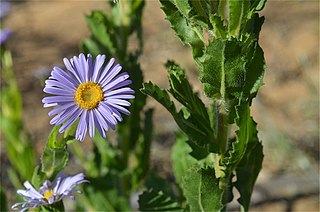
Olearia argophylla, commonly known as musk daisy-bush, native musk or silver shrub, is a species of flowering plant in the family Asteraceae and is endemic to south-eastern Australia. It is a shrub or tree with silvery branchlets, egg-shaped to elliptic leaves, and white and yellow, daisy-like inflorescences.

Olearia axillaris, commonly known as coastal daisy-bush, coast daisy-bush or coastal daisybush is a species of flowering plant in the family Asteraceae and is endemic to coastal areas of Australia. It is an erect, bushy shrub with densely cottony-hairy branchlets, aromatic, linear to narrowly elliptic or narrowly lance-shaped to egg-shaped leaves with the narrower end towards the base and small white and yellow, daisy-like inflorescences.

Olearia pimeleoides, commonly known as pimelea daisy-bush, is a species of flowering plant in the family Asteraceae and is endemic to southern continental Australia. It is an erect shrub with elliptic, linear or lance-shaped leaves, and white and pale yellow, daisy-like inflorescences.

Olearia ramulosa, commonly known as twiggy daisy-bush, is a species of flowering plant in the family Asteraceae and is endemic to south-eastern Australia. It is a shrub with narrowly elliptic, linear or narrowly egg-shaped leaves, and pale blue, mauve or white and yellow, daisy-like inflorescences.

Olearia algida, the alpine daisy-bush is a species of flowering plant in the family Asteraceae and is endemic to south-eastern Australia. It is a shrub with small, crowded, elliptic to narrow egg-shaped leaves with the narrower end towards the base and heads of white and cream-coloured, daisy-like flowers.

Olearia megalophylla, commonly known as large-leaf daisy bush, is a species of flowering plant in the family Asteraceae and is endemic to south-eastern continental Australia. It is a spreading shrub with egg-shaped to elliptic leaves and white and yellow, daisy-like inflorescences.

Olearia covenyi is a species of flowering plant in the family Asteraceae and is endemic to New South Wales. It is a shrub with scattered egg-shaped leaves, and white and yellow, daisy-like inflorescences.

Olearia canescens is a species of flowering plant in the family Asteraceae and is endemic to eastern Australia. It is a shrub with scattered elliptic or egg-shaped leaves, and white and yellow, daisy-like inflorescences.

Olearia myrsinoides, commonly known as silky daisy-bush or blush daisy bush, is a species of flowering plant in the family Asteraceae and is endemic to south-eastern Australia. It is a spreading shrub with hairy branchlets, egg-shaped to elliptic leaves with toothed edges, and white and yellow or mauve, daisy-like inflorescences.

Olearia oppositifolia is a species of flowering plant in the family Asteraceae and is endemic to eastern Australia. It is a shrub with egg-shaped to elliptic leaves arranged in opposite pairs, and white and yellow daisy flowers.
Olearia burgessii is a species of flowering plant in the family Asteraceae and is endemic to south-eastern New South Wales. It is a shrub with scattered elliptic to egg-shaped leaves with the narrower end towards the base, and white and yellow, daisy-like inflorescences.

Olearia calcarea, commonly known as limestone daisy bush, is a species of flowering plant in the family Asteraceae and is endemic to southern continental Australia. It is a shrub with egg-shaped or broadly spoon-shaped leaves with toothed edges, and white and yellow, daisy-like inflorescences.
Olearia gravis is a species of flowering plant in the family Asteraceae and is endemic to south-eastern Australia. It is a shrub with elliptic or egg-shaped leaves and white and yellow, daisy-like inflorescences.
Olearia heterocarpa, commonly known as Nightcap daisy bush, is a species of flowering plant in the family Asteraceae and is endemic to eastern Australia. It is a shrub with narrowly elliptic or lance-shaped leaves with toothed edges, and white and yellow, daisy-like inflorescences.
Olearia incana is a species of flowering plant in the family Asteraceae and is endemic to southern Australia. It is a shrub with narrowly elliptic or wedge-shaped leaves and white and pale yellow, daisy-like inflorescences.

Olearia lepidophylla, commonly known as club-moss daisy-bush, is a species of flowering plant in the family Asteraceae and is endemic to southern Australia. It is a rigid, erect to spreading shrub with tiny oblong to egg-shaped leaves and white and yellow, daisy-like inflorescences.

Olearia nernstii is a species of flowering plant in the family Asteraceae and is endemic to eastern Australia. It is a shrub with scattered egg-shaped to elliptic leaves with toothed or prickly edges, and white and yellow, daisy-like inflorescences.

Olearia quercifolia, commonly known as oak-leaved olearia, is a species of flowering plant in the family Asteraceae, and is endemic to the Blue Mountains in New South Wales. It is a shrub with elliptic to egg-shaped leaves with the narrower end towards the base, and white and yellow daisy flowers.

Olearia ramosissima, commonly known as much-branched daisy bush, is a species of flowering plant in the family Asteraceae and is endemic to continental Australia. It is a straggly shrub with densely-crowded, elliptic, egg-shaped or triangular leaves, and blue to violet and blue or yellow, daisy-like inflorescences.

Olearia rudis, commonly known as azure daisy-bush, is a species of flowering plant in the family Asteraceae and is endemic to eastern Australia. It is a usually short-lived shrub with crowded elliptic or egg-shaped leaves, and pale blue, mauve or purple and orange, daisy-like inflorescences.
















